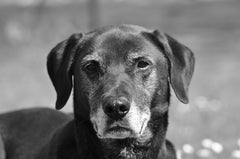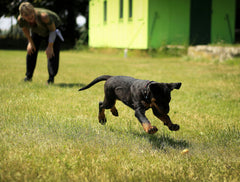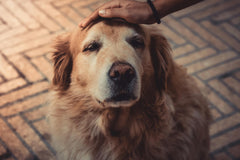
The Chesapeake dog is a beautiful breed of retriever with a fascinating history and lovely personality. Anyone who is lucky enough to adopt a Chesapeake Bay retriever rescue dog or puppy is in for a happy companionship with this breed of dog. Especially when they are a puppy.
This breed has a lot to be learned about it in order to fully understand what makes them special and how to best care for them as your family pet.
History

This retriever dog got its name from the area where they became most popular, the Chesapeake Bay. In this area they were owned by the rich duck club owners of the region. Experts are still unsure of which breeds were brought together to create the Chesapeake Bay retriever. They theorize that it could be a combination of Newfoundland and Irish Water Spaniel.
To understand the Chesapeake Bay retriever puppy, one must learn about the area that their breed originated. The area the Chesapeake Bay is located, between Maryland and Virginia, is also home to something called the “Atlantic flyway”. This is a path by which thousands of ducks and geese migrate through every year like clockwork. Statistics tell us that one third of all migratory waterfowl hunker down here when spending winter on the east coast.
Duck hunters of the time did what they could to essentially “create” the perfect duck hunting companion. They combined the breeds that they already knew were best suited to take on the frigid waters of the Chesapeake Bay at this time of year.
Whatever they did they did it right because the Chesapeake Bay retriever’s fur coat is both waterproof and well insulated, making them great for swimming. Not to mention, these pups had webbed feet which were perfect for taking on the waters of the Chesapeake Bay to retrieve the ducks as the hunters gunned them down.
Personality

Chessie puppies are great canine companions, but one must be ready to take a Chesapeake Bay retriever on when considering adopting one. They are lovable, friendly, and obedient by nature, but can overpower an unprepared owner with their smarts and strength.
You need to be familiar with structured training methods to really acclimate a Chessie puppy to home live a life with a human family. They need discipline and daily physical activity. They especially love to swim, so any opportunity you can give a Chessie to get in the water and expend some of their energy doing what they love will be well worth the time spent.
Exposing your puppy to social situations with other humans and other dogs at a young age is important, no matter the breed. With the Chessie, early socialization is good because they are a naturally shy breed of dog. They don’t generally open up and become super friendly with strangers right off the bat. It’s important that your Chessie knows that you are the boss and that they need to be listening to you and your commands in any social situation.
Diet

Any kind of high-quality puppy food, dry and wet, will do for the Chesapeake Bay retriever puppy. Unless otherwise instructed by your puppy’s vet. They are an incredibly active breed, so any food that has a high amount of protein is a good choice while they are regularly active.
Keep in mind that you will be giving them lots of treats through the training process since positive reinforcement tends to work especially well with Chessies. These are extra calories that should be accounted for when preparing their food at mealtimes.
Health

The Chesapeake Bay Retriever lifespan is an average one for a dog their size. They are known to live 10-12 years on average when they are well taken care of and live in a happy home. Responsible dog breeders will generally run all necessary tests on their puppies before adopting them off to a new home. These tests should detect any early signs of health problems that the pups could be facing.
Hip dysplasia is a common health concern among several breeds of dogs but is one that owners of Chesapeake Bay retriever owners should keep an eye out for. Checking your Chessies ears regularly for any problems, as well as keeping up with good dental hygiene practices are both important in the care for a Chesapeake Bay retriever.
Conclusion
The Chesapeake Bay retriever can make a wonderful companion or family dog. They are loyal and obedient when trained properly but can be shy yet so full of energy. Someone who wants to adopt a Chesapeake Bay retriever needs to be ready to put in the work of both training them well and doing whatever is necessary to allow them to expend energy daily. Whether that is going for walks or heading to a local dog park to toss around a ball or frisbee. The Chessie may sound like a handful but they are well worth the work if you are ready for it.
Are Chesapeake Bay retrievers hypoallergenic?
Can you shave a Chesapeake Bay retriever?
When do Chesapeake Bay retrievers stop growing?
Related Posts:
- Types of Retriever Dog Breeds
- 5 American Dog Breeds You Need To Know
- Australian Retriever: 5 Reasons This Dog Breed is the Best





Comments
I ama former Chesapeake owner now retired a time to spend with a dog. Im interested in a Chesapeake only.